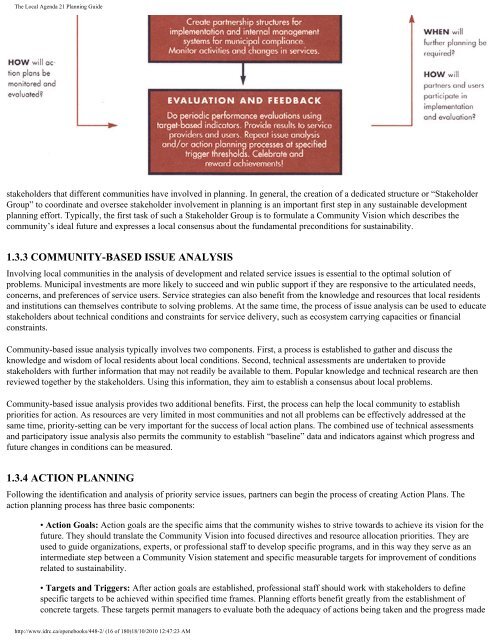The Local Agenda 21 Planning Guide - Democrats Against UN ...
The Local Agenda 21 Planning Guide - Democrats Against UN ...
The Local Agenda 21 Planning Guide - Democrats Against UN ...
Create successful ePaper yourself
Turn your PDF publications into a flip-book with our unique Google optimized e-Paper software.
<strong>The</strong> <strong>Local</strong> <strong>Agenda</strong> <strong>21</strong> <strong>Planning</strong> <strong>Guide</strong><br />
stakeholders that different communities have involved in planning. In general, the creation of a dedicated structure or “Stakeholder<br />
Group” to coordinate and oversee stakeholder involvement in planning is an important first step in any sustainable development<br />
planning effort. Typically, the first task of such a Stakeholder Group is to formulate a Community Vision which describes the<br />
community’s ideal future and expresses a local consensus about the fundamental preconditions for sustainability.<br />
1.3.3 COMM<strong>UN</strong>ITY-BASED ISSUE ANALYSIS<br />
Involving local communities in the analysis of development and related service issues is essential to the optimal solution of<br />
problems. Municipal investments are more likely to succeed and win public support if they are responsive to the articulated needs,<br />
concerns, and preferences of service users. Service strategies can also benefit from the knowledge and resources that local residents<br />
and institutions can themselves contribute to solving problems. At the same time, the process of issue analysis can be used to educate<br />
stakeholders about technical conditions and constraints for service delivery, such as ecosystem carrying capacities or financial<br />
constraints.<br />
Community-based issue analysis typically involves two components. First, a process is established to gather and discuss the<br />
knowledge and wisdom of local residents about local conditions. Second, technical assessments are undertaken to provide<br />
stakeholders with further information that may not readily be available to them. Popular knowledge and technical research are then<br />
reviewed together by the stakeholders. Using this information, they aim to establish a consensus about local problems.<br />
Community-based issue analysis provides two additional benefits. First, the process can help the local community to establish<br />
priorities for action. As resources are very limited in most communities and not all problems can be effectively addressed at the<br />
same time, priority-setting can be very important for the success of local action plans. <strong>The</strong> combined use of technical assessments<br />
and participatory issue analysis also permits the community to establish “baseline” data and indicators against which progress and<br />
future changes in conditions can be measured.<br />
1.3.4 ACTION PLANNING<br />
Following the identification and analysis of priority service issues, partners can begin the process of creating Action Plans. <strong>The</strong><br />
action planning process has three basic components:<br />
• Action Goals: Action goals are the specific aims that the community wishes to strive towards to achieve its vision for the<br />
future. <strong>The</strong>y should translate the Community Vision into focused directives and resource allocation priorities. <strong>The</strong>y are<br />
used to guide organizations, experts, or professional staff to develop specific programs, and in this way they serve as an<br />
intermediate step between a Community Vision statement and specific measurable targets for improvement of conditions<br />
related to sustainability.<br />
• Targets and Triggers: After action goals are established, professional staff should work with stakeholders to define<br />
specific targets to be achieved within specified time frames. <strong>Planning</strong> efforts benefit greatly from the establishment of<br />
concrete targets. <strong>The</strong>se targets permit managers to evaluate both the adequacy of actions being taken and the progress made<br />
http://www.idrc.ca/openebooks/448-2/ (16 of 180)18/10/2010 12:47:23 AM










